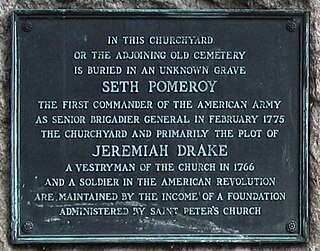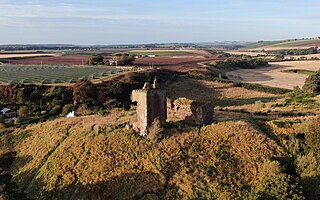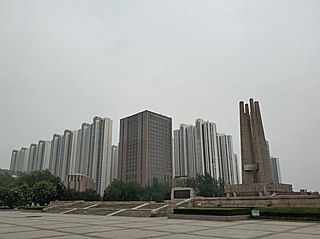Related Research Articles

Arthur Thistlewood was an English radical activist and conspirator in the Cato Street Conspiracy. He planned to murder the cabinet, but there was a spy and he was apprehended with 12 other conspirators. He killed a policeman during the raid. He was executed for treason.

A vestryman is a member of his local church's vestry, or leading body. He is not a member of the clergy.

Red Castle of Lunan is a ruined fortified house on the coast of Angus, Scotland. It is about 4 miles (6.4 km) south-southwest of Montrose.

Duncan Alasdair Lunan, born October 1945, is a Scottish author with emphasis on astronomy, spaceflight and science fiction, undertaking a wide range of writing and speaking on those and other topics as a researcher, tutor, critic, editor, lecturer and broadcaster. He is known for his science writings as well as for his work on the Sighthill stone circle.

Lunan is a hamlet in Angus, Scotland, in the parish of the same name, 6 kilometres (3.7 mi) south of Montrose. The hamlet overlooks Lunan Bay, which is itself also a hamlet, at the mouth of the Lunan Water. A 16th-century priest of Lunan church, which is in the hamlet of Lunan Bay, Walter Mill, was one of the last Scottish Protestant martyrs to be burned at St. Andrews. The church itself was rebuilt in 1844. The 15th-century Red Castle, so called from the red sandstone it is built from, is located 500 metres (1,600 ft) to the south of the hamlet, on the south bank of the Lunan Water.

Ira Lunan Ferguson, B.A., B.Sc., M.A., M.Sc., Ph.D., LL.B. was an American psychologist and author of multiple autobiographies as well as several novels and many published essays and journal articles. He is perhaps best known for his autobiographical trilogy, I Dug Graves at Night to Attend College by Day (1968–70).

Lunan District is a district of the city of Tangshan, Hebei province, China. The district spans an area of 110.92 square kilometres (42.83 sq mi), and has a population of approximately 330,000 per a 2021 government publication.
Sligoville is a small community approximately 10 miles from Spanish Town in the parish of St. Catherine on the island of Jamaica.

George Watson-Taylor, of Saul's River, Jamaica, was a plantation owner and Member of Parliament (MP) at Westminster. In 1810 he married into the family of the planter Sir John Taylor, 1st Baronet, in time adding the Taylor surname to his own, and becoming the richest planter on Jamaica. He bought a house in Cavendish Square, London, and Erlestoke Park, near Devizes, Wiltshire. As MP for a number of constituencies, where he was brought in without contests, he supported the Tory administration, and campaigned for the retention of slavery.

The Jamaica Station was a formation or command of the United Kingdom's Royal Navy stationed at Port Royal in Jamaica from 1655 to 1830.
Jamaica Dockyard also known as Port Royal Dockyard was a British Royal Navy Dockyard located at Port Royal, Jamaica. It was established 1675 and closed in 1905. The dockyard was initially administered by the Navy Board then later the Board of Admiralty.
John Blythe was the owner of the Kendal and Tweedside estates in Westmoreland Parish, Jamaica. He was elected to the House of Assembly of Jamaica in 1820.
John Hanson was a planter in Jamaica and the owner of the Salt Pond Pen. He inherited this estate from his father, the planter and slave owner John Hanson. He was elected to the House of Assembly of Jamaica in 1820.
John Holmes (1763-1836) was a planter and slave-owner in Jamaica. He was elected to the House of Assembly of Jamaica in 1820.
John Rawleigh Jackson was a planter and slave-owner in Jamaica. He was elected to the House of Assembly of Jamaica in 1820 representing Port Royal where he was also the chief magistrate in 1831.
John Mais (1778-1853) was a planter and slave-owner in Jamaica. He was elected to the House of Assembly of Jamaica in 1820 for the parish of Saint Andrew.
William Shand was elected to the House of Assembly of Jamaica in 1820 for the parish of Saint John.
John Williams was a planter and slave-owner in Jamaica. He owned the Cool Spring Plantation in Clarendon Parish and had an interest in Provost's Rock River plantation. He had family connections to the Isle of Wight in England. He was elected to the House of Assembly of Jamaica in 1820 for the parish of Clarendon.
David Gordon Lunan was a Canadian Army officer who, in 1946, was convicted of espionage on behalf of the Soviet Union. Lunan was identified as a spy by Igor Gouzenko when he defected from the Soviet Embassy in Ottawa in September 1945 and launched what became known as the Gouzenko Affair. Lunan had acted as a handler for three other accused spies: Israel Halperin, Edward Mazerall, and Durnford Smith. He was sentenced to five years' imprisonment and given two additional sentences totalling 15 months for contempt of court when he refused to testify against Halperin and Fred Rose.
References
- ↑ John Lunan. Legacies of British Slave-ownership, University College London. Retrieved 26 April 2019.
- ↑ Hakewill, James. (1825) A Picturesque Tour of the Island of Jamaica, From Drawings Made in the Years 1820 and 1821. London: Hurst and Robinson & E. Lloyd. p. 13.